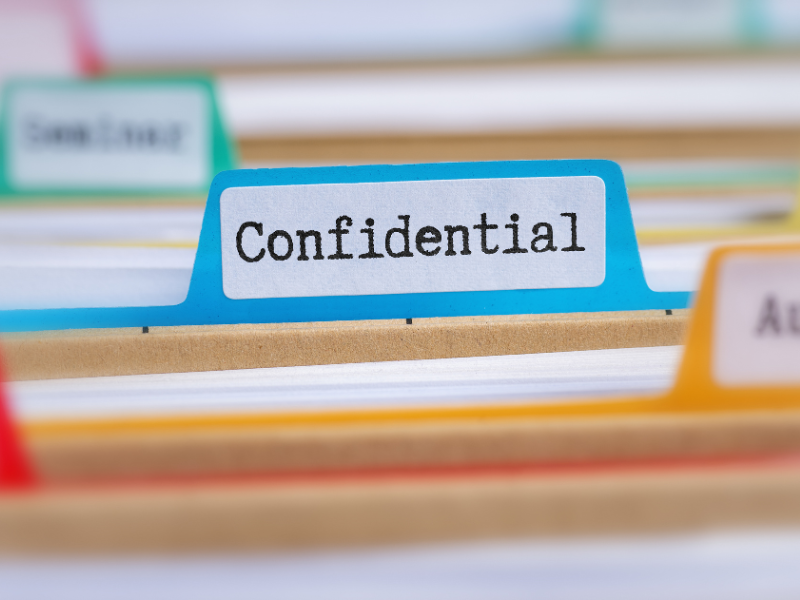Patients trust healthcare providers to keep their sensitive information confidential and secure. And yet, too often, medical records are subject to numerous data breaches. Recent statistics show that 90% of healthcare organizations suffer from at least one security breach, with 30% of these breaches occurring in large hospitals.
With 95% of identity thefts coming from stolen medical records, healthcare organizations must observe medical records security protocols to safeguard patient data. Here are ten ways to properly secure medical records and prevent unwanted data breaches.
10 Best Practices for Securing Medical Records:

When patient data is compromised, it jeopardizes the individual’s privacy and undermines the trust the patient placed in your organization. Data breaches have far-reaching repercussions, including reputational damages, legal consequences, and regulatory penalties.
The following best practices can help mitigate the risks associated with data breach incidents:
1. Create Stringent Access Controls
Your first line of defense against hackers is ensuring that only authorized individuals have access to patient records in the first place. You need to create role-based access permissions where different individuals can only access specific information required to carry out their roles properly. Designate administrators responsible for creating permissions and privileges for various individuals must conduct regular audits to review and update access privileges.
Enforce strong passwords among employees and require that these are regularly updated and kept in secure password management tools. You can also enforce multi-factor authentication (MFA) as an extra layer of security.
2. Implement In-Transit and At-Rest Encryption
Encryption acts as a powerful shield for medical records, both in transit and at rest. Encrypting sensitive data ensures that even if malicious actors intercept them, the information remains unusable and unintelligible.
You should use strong encryption algorithms to protect data during transmission over networks and when stored on servers or other storage devices. Use protocols like HTTPs or tools like VPNs that provide end-to-end encryption. When it comes to servers and databases, ensure any stored data are encrypted and can only be deciphered by a decryption key.
3. Monitor System Activity
Securing medical records requires being proactive in detecting and identifying possible threats. You can do this by constantly monitoring system activity and looking for suspicious behavior and unauthorized access attempts.
Use robust monitoring systems to monitor network traffic, user activity, and system behaviors in real time. These systems must have automated alert mechanisms so your security teams will be notified of detected anomalies immediately, and they can respond to possible threats on time. There should also be detailed logs so you can conduct regular log analysis to uncover any indicators or insights on potential breaches.
4. Perform Regular Data Backups
Regularly backing up medical records and storing copies in secure, offsite locations ensures data recovery in the event of accidental deletion, system failures, or cyberattacks. You should periodically test data restoration procedures to maintain the integrity of your backups. Observe a regular data backup schedule conducted in appropriate intervals.
You can also consider a redundant backup system, including maintaining multiple copies of data in different secure locations. Document your data recovery procedures to make it easy to restore data from backups in case needed.
5. Develop a Strong Incident Response Plan
Developing a robust incident response involves having clear procedures for identifying, reporting, and mitigating security incidents, coupled with regular drills and simulations. This ensures readiness in the face of a security breach.
There must be clear responsibilities and communication protocols aimed at providing prompt response and minimizing the impact of security breaches. Your plan should focus on containing and eradicating the problem and swiftly recovering data after a breach. To maintain trust and transparency, include timely communication with all stakeholders, including patients.

6. Don’t Overlook Physical Security
Physical security measures are as crucial as digital ones. Enforce restricted access to areas where paper records are stored, install security cameras, and invest in access control systems. Conduct regular physical audits to identify any weaknesses, such as periodic physical inspections, reviews of access logs, tests of alarm systems, and the like. This will create a holistic approach to medical records security.
7. Remain Updated With Regulatory Compliance Requirements
Staying abreast of data protection and healthcare regulations like HIPAA or GDPR is non-negotiable. Compliance assessments and audits should be conducted regularly to ensure adherence to these regulations, avoiding legal repercussions.
Check that your team thoroughly understands these regulations and the consequences of not observing them. Collaborate with compliance professionals to audit your practices and get guidance on how to maintain compliance with changing regulatory requirements.
8. Train Employees
Human factors are a significant contributor to security vulnerabilities. Provide comprehensive training for staff on data security best practices, patient confidentiality, and secure medical records management. Conduct regular refresher courses to update employees on evolving security threats and protocols.
Promote a culture of heightened security awareness where employees are encouraged and empowered to report suspicious incidents and activities.
9. Check Third-Party Vendor Security
When third-party vendors are involved, it’s crucial to ensure they adhere to strict security standards. Always conduct rigorous selection processes, regular assessments, and inclusion of security requirements in contracts to contribute to a secure vendor ecosystem.
As healthcare organizations, it’s crucial to work only with HIPAA-compliant vendors willing to sign BAAs (Business Associate Agreements) indicating their commitment to patient data security.

10. Discourage Shadow IT
With plenty of third-party apps in the market, it’s typical for employees to use unapproved applications just to get the job done. This is called shadow IT, a practice that’s convenient for the user but can pose risks to security. Learn why your staff use unsanctioned apps and look for credible replacements that are secure and compliant. Stress the importance of maintaining secure medical records and how unapproved apps compromise security.
Key Components of Secure Medical Records Management
Securing medical records involves an integrated approach that combines technological solutions, policy frameworks, and a culture of security awareness. The abovementioned strategies show how these essential components protect patient information while ensuring confidentiality and data integrity.
Medical records must be stored in devices that follow the latest encryption technologies, while policy frameworks must be developed to govern access to such devices. Organizations must cultivate security awareness where everyone understands their core responsibilities in keeping information safe.
Securing patient data is not just a legal obligation but a fundamental ethical responsibility that every healthcare provider must adhere to. With these best practices, you can establish your organization’s credibility, instilling a culture of integrity and trust.







